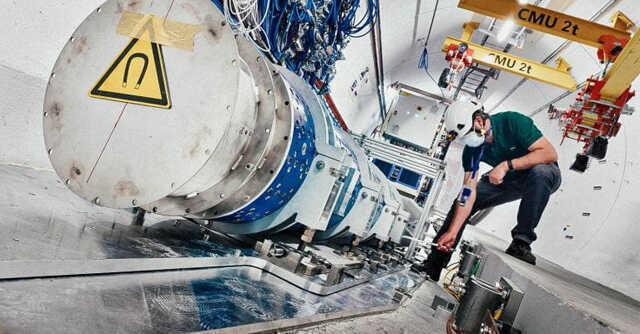
Scientists detect Neutrino signs in Large Hadron Collider for first time


For the first time, scientists at the Large Hadron Collider (LHC) have observed neutrino trails courtesy a specialised apparatus.
While this is certainly not for the first time that neutrinos have been detected, but in a first it has been done in an artificially-controlled environment.
Neutrinos are fundamental particles of the universe. They are among the least understood particles in the standard model of particle physics, with neutrinos produced within a particle collider having never been directly detected.

The LHC, on the other hand, is the world’s largest particle collider, which extends in the shape of a 27km-long ring. It is at the forefront of research in particle physics, and has been instrumental in helping mankind replicate various conditions of the universe in a controlled environment.
The eventual goal for LHC and its maker, the Swiss European Organisation for Nuclear Research (CERN), is to understand how the universe took shape the way it is today – and innumerable related aspects of it.
Neutrinos, on its part, have been an enigma for many. They are known to be one of the fundamental building blocks of the universe, as neutrinos cannot be further broken down into smaller particles as per present knowledge.

These chargeless particles were for the longest time also believed to carry no mass either, which was proved wrong by later research that they do carry mass, indeed.
However, their particular mass is extremely low, which makes studying the particles a tricky affair. So far, specialised instruments such as the Super-Kamiokande neutrino detector and the IceCube neutrino observatory in Antarctica have conducted neutrino studies, detecting signs of the particles from their natural sources.
Neutrinos are natural indicators of the functioning of stars in solar systems strewn all across the universe. Activity of these fundamental particles are typical identifiers of the formation of supernovae, or dying stars, where the decay of protons (positively charged particles) from the concerned star would give birth to a burst of neutrinos into space.

For the longest time, scientists have believed that better fundamental understanding of neutrinos is critical to answering a number of fundamental questions regarding the formation of the universe, why it exists in matter instead of antimatter, and so on. It is this factor that makes the detection of neutrino signs at the LHC, through a particle detector instrument called FASER by Forward Search Experiment scientists from the University of California, Irvine, extremely significant.
“This significant breakthrough is a step toward developing a deeper understanding of these elusive particles and the role they play in the universe. This verifies that the position forward of the ATLAS interaction point at the LHC is the right location for detecting collider neutrinos.
Our efforts also demonstrated the effectiveness of using an emulsion detector to observe these kinds of neutrino interactions,” said Jonathan Feng, co-leader of FASER and co-author of the study that has been published in the journal Physical Review D on November 24, 2021.

The scientists involved in the project now state that they aim to scale up their efforts towards detecting higher energy neutrinos through the LHC, through 2022.
The efforts should help produce further breakthroughs towards understanding how neutrinos contribute towards building the universe as we know it, which in turn can potentially offer key identifiers for mankind to understand in which areas of the vast universe can life flourish.
